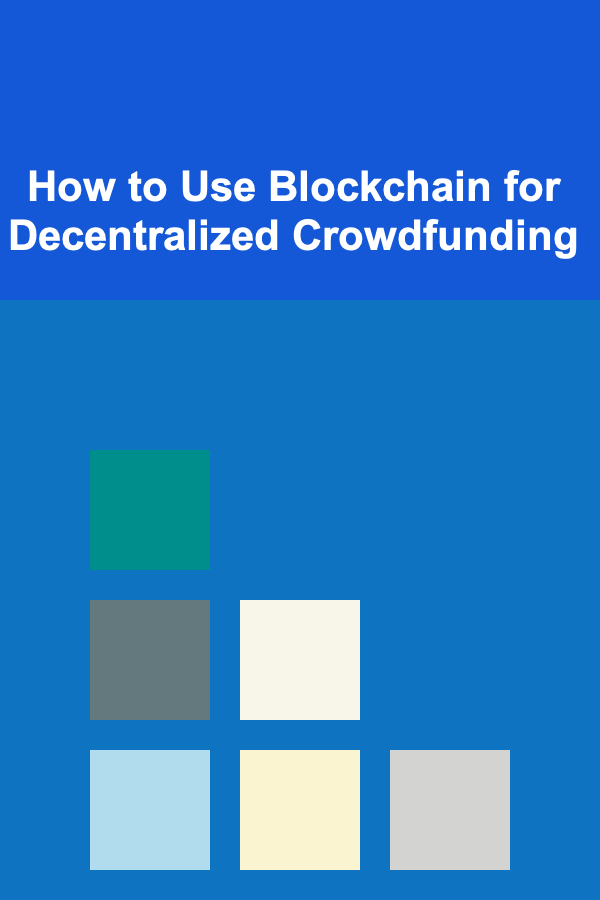
How to Use Blockchain for Decentralized Crowdfunding
ebook include PDF & Audio bundle (Micro Guide)
$12.99$5.99
Limited Time Offer! Order within the next:

In the modern world, crowdfunding has become a powerful tool for individuals, startups, and organizations to raise funds. Traditional crowdfunding platforms, such as Kickstarter and GoFundMe, have facilitated millions of campaigns, but they are often limited by centralized structures. These platforms usually take a fee from the funds raised, and they can be subject to censorship, fraud, and misuse. Blockchain technology, however, offers an alternative by providing a decentralized, transparent, and secure method for crowdfunding. This article explores how blockchain can revolutionize crowdfunding by eliminating intermediaries, enhancing security, and fostering trust.
Understanding Blockchain and Crowdfunding
Before delving into the specifics of decentralized crowdfunding, it's important to understand what blockchain technology and crowdfunding entail.
What is Blockchain?
Blockchain is a distributed ledger technology that ensures data integrity and transparency by storing information across multiple computers in a decentralized network. Each block in the blockchain contains a list of transactions, and once information is added, it cannot be altered or deleted. This creates an immutable and secure record of all transactions, making it ideal for applications where transparency and trust are crucial.
What is Crowdfunding?
Crowdfunding is the practice of raising small amounts of money from a large number of people, typically via the internet, to fund a specific project or venture. It has become a popular way for entrepreneurs to secure capital without the need for traditional investors or financial institutions. Crowdfunding is often conducted through centralized platforms that connect project creators with potential backers.
The Limitations of Traditional Crowdfunding
While crowdfunding has democratized access to capital, traditional platforms have several limitations:
1. Centralization
Traditional crowdfunding platforms act as intermediaries between project creators and backers. They control the funds, take fees, and often set rules that can limit the types of projects that can be funded. This centralization makes the process vulnerable to issues such as censorship, delays, or even fraud.
2. High Fees
Crowdfunding platforms usually charge fees ranging from 5% to 10% of the funds raised, which can significantly reduce the amount of money available for the project. Additionally, there are often payment processing fees, which further diminish the funds that go to the campaign.
3. Lack of Transparency
Many crowdfunding platforms lack full transparency regarding how funds are managed. Project creators and backers may not always have a clear view of how the funds are allocated, which can lead to trust issues.
4. Geographic and Legal Barriers
Crowdfunding platforms are typically subject to the laws and regulations of the countries in which they operate. This can limit the ability of people from certain regions or countries to participate in crowdfunding campaigns.
How Blockchain Solves These Problems
Blockchain technology can address many of the issues inherent in traditional crowdfunding systems by introducing a decentralized, transparent, and trustless ecosystem. Let's explore how blockchain can solve the above-mentioned problems.
1. Decentralization
Blockchain enables decentralized crowdfunding, meaning that there is no need for an intermediary to manage the funds. Smart contracts---self-executing contracts with the terms of the agreement directly written into code---can automate the crowdfunding process. This ensures that funds are directly transferred between the backers and the project creators, without the need for a third-party platform.
2. Lower Fees
By eliminating intermediaries, blockchain can significantly reduce the fees associated with crowdfunding. Transaction fees on blockchain platforms are typically lower than the fees charged by traditional crowdfunding platforms. Additionally, there are no processing fees, as transactions can be directly handled by the blockchain network.
3. Transparency
Blockchain provides full transparency, as all transactions are recorded on the ledger and are publicly accessible. This means that backers can track how their contributions are being used, and project creators can demonstrate accountability. This level of transparency increases trust and reduces the risk of fraud or misuse of funds.
4. Global Accessibility
Blockchain operates on a global scale, allowing anyone with an internet connection to participate in a crowdfunding campaign. This removes geographic barriers and makes crowdfunding accessible to a larger pool of backers. Moreover, blockchain platforms can overcome legal restrictions by using cryptocurrency, which can bypass some of the limitations of traditional currency.
Components of Decentralized Crowdfunding
To better understand how decentralized crowdfunding works, we need to examine the key components involved.
1. Cryptocurrency
Cryptocurrency plays a central role in decentralized crowdfunding. It serves as the medium of exchange, allowing backers to contribute funds to a campaign without the need for traditional banking systems. Cryptocurrencies like Bitcoin, Ethereum, and others are widely used in decentralized crowdfunding platforms. They provide a fast, secure, and low-cost method of transferring funds across borders.
2. Smart Contracts
Smart contracts are at the heart of decentralized crowdfunding. These contracts automatically execute the terms of the agreement once certain conditions are met. In the context of crowdfunding, a smart contract can define the funding goal, deadlines, and the distribution of funds. If the funding goal is met by the deadline, the smart contract will release the funds to the project creator. If the goal is not met, the contract will return the funds to the backers.
Smart contracts eliminate the need for intermediaries and provide a trustless system, ensuring that funds are handled according to the predefined rules.
3. Decentralized Platforms
To facilitate decentralized crowdfunding, platforms are needed that are built on blockchain technology. These platforms do not have a central authority controlling the campaigns, allowing creators to raise funds without needing to go through traditional intermediaries. These platforms can use cryptocurrencies and smart contracts to handle the entire crowdfunding process.
Some existing blockchain-based platforms that support decentralized crowdfunding include:
- Ethereum-based platforms: Ethereum's smart contract capabilities make it a popular choice for decentralized crowdfunding campaigns. Platforms like Kickstarter and GoFundMe can potentially be replicated on Ethereum using smart contracts.
- DAOs (Decentralized Autonomous Organizations): A DAO is a governance structure that operates on a blockchain, where decision-making power is distributed among the participants. DAOs can be used for decentralized crowdfunding by allowing the community to vote on projects and allocate funds.
- Initial Coin Offerings (ICOs) and Token Sales: ICOs and token sales are crowdfunding mechanisms used by startups to raise capital by issuing their own cryptocurrency tokens. These tokens can be used to access a product or service in the future, or they can be traded on cryptocurrency exchanges.
4. Tokenization
Tokenization is a key concept in blockchain-based crowdfunding. Tokens are digital representations of assets, and they can be issued by project creators to backers in exchange for their contributions. These tokens may represent shares in a project, future access to a product or service, or other forms of value.
Tokenization allows project creators to offer incentives or rewards to backers, making it an attractive way to raise funds. Additionally, tokenized assets can be traded on cryptocurrency exchanges, providing liquidity to backers.
The Process of Decentralized Crowdfunding
Now that we have discussed the key components, let's break down the typical process of decentralized crowdfunding:
1. Creating a Campaign
The project creator initiates the crowdfunding campaign by creating a smart contract on a decentralized platform. The smart contract defines the terms of the campaign, including the funding goal, timeline, and how the funds will be used. Additionally, the campaign may include details such as rewards or incentives for backers.
2. Fundraising
Backers contribute funds to the campaign by sending cryptocurrency to the smart contract address. The smart contract will automatically track the contributions and ensure that the funds are allocated according to the campaign's rules. Backers receive tokens as a form of proof of their contribution, which may grant them rewards, voting rights, or a share in the project.
3. Meeting the Funding Goal
If the campaign meets its funding goal by the deadline, the smart contract will release the funds to the project creator. If the goal is not met, the smart contract will return the funds to the backers. This mechanism ensures that project creators only receive funding if there is sufficient support, reducing the risk of failure.
4. Project Execution
Once the funds are raised, the project creator can begin executing the project. Backers can continue to track the progress of the project through the blockchain, ensuring transparency throughout the process. Any milestones or updates can be recorded on the blockchain, providing an immutable record of progress.
5. Distribution of Rewards
At the end of the project, rewards or incentives promised to backers are distributed according to the terms of the smart contract. If the project involves tokenization, backers may receive tokens that can be traded or redeemed for products or services.
Benefits and Challenges of Decentralized Crowdfunding
Benefits
- Transparency and Trust: Blockchain's transparent nature ensures that all transactions are visible to backers, fostering trust between project creators and their supporters.
- Lower Fees: By eliminating intermediaries, blockchain reduces the fees associated with crowdfunding.
- Global Reach: Blockchain platforms allow people from around the world to participate in crowdfunding campaigns, removing geographical barriers.
- Security: Blockchain provides a secure and immutable record of transactions, reducing the risk of fraud or misuse of funds.
Challenges
- Regulatory Uncertainty: The legal status of cryptocurrencies and blockchain-based crowdfunding is still evolving, and regulations can vary by country.
- Technical Barriers: The use of cryptocurrency and blockchain technology may be challenging for those who are not familiar with the technology.
- Market Volatility: Cryptocurrencies are often volatile, which can affect the value of the funds raised in a campaign.
- Adoption: Decentralized crowdfunding is still a relatively new concept, and widespread adoption may take time.
Conclusion
Blockchain technology has the potential to revolutionize crowdfunding by making it more decentralized, transparent, and secure. By using smart contracts, cryptocurrencies, and decentralized platforms, project creators can raise funds without relying on intermediaries. This creates a more efficient and trustless ecosystem for crowdfunding, which can benefit both project creators and backers.
However, there are challenges that must be addressed, including regulatory uncertainty and technical barriers. As the technology continues to evolve and gain adoption, decentralized crowdfunding may become a mainstream alternative to traditional crowdfunding methods.
Reading More From Our Other Websites
- [Organization Tip 101] How to Organize Your Home Inventory for Tax Deductions
- [Home Soundproofing 101] How to Soundproof Your Home for Better Audio and Video Quality
- [Organization Tip 101] How to Create a Vintage Craft Supplies System
- [Mindful Eating Tip 101] Best Mindful Eating for Gut Health: Nourishing Your Microbiome
- [Home Budget 101] How to Save for Retirement While Managing Daily Expenses
- [Organization Tip 101] How to Create a Sustainable Home Organization System
- [Stamp Making Tip 101] Crafting Professional-Quality Stamps at Home with a Kit -- Tips & Tricks
- [Organization Tip 101] How to Collaborate with Your Wedding Planner for Success
- [Organization Tip 101] Why Organizing Your Closet by Season Simplifies Outfit Choices
- [Digital Decluttering Tip 101] How to Turn Digital Clutter into a Structured Knowledge Base for Consultants

How to Create a Welcome Area for New Volunteers
Read More
How to Maintain Your Home's Homeowner's Warranty and Documentation
Read More
How to Safeguard Your Home from Cybersecurity Threats
Read More
How to Soundproof Your Home for More Privacy
Read More
How to Choose the Best Water Bottle or Hydration System
Read More
How to Become a Background Actor in Hollywood
Read MoreOther Products

How to Create a Welcome Area for New Volunteers
Read More
How to Maintain Your Home's Homeowner's Warranty and Documentation
Read More
How to Safeguard Your Home from Cybersecurity Threats
Read More
How to Soundproof Your Home for More Privacy
Read More
How to Choose the Best Water Bottle or Hydration System
Read More